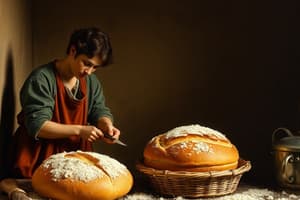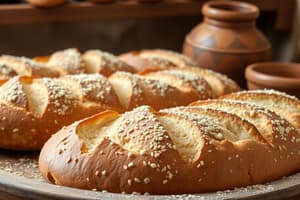Podcast
Questions and Answers
Which ingredient is NOT typically considered a basic component of cookie recipes?
Which ingredient is NOT typically considered a basic component of cookie recipes?
- Baking soda
- Solid fats
- Honey (correct)
- Eggs
What type of leavening agent is NOT classified as a common option in baking?
What type of leavening agent is NOT classified as a common option in baking?
- Baking powder
- Cornstarch (correct)
- Yeast
- Baking soda
Which characteristic defines leavened bread in contrast to unleavened bread?
Which characteristic defines leavened bread in contrast to unleavened bread?
- Presence of preservatives
- Utilization of rising agents (correct)
- Absence of air pockets
- Addition of sweeteners
Which type of pastry is characterized by its layered texture due to folding butter into the dough?
Which type of pastry is characterized by its layered texture due to folding butter into the dough?
During which historical period did the use of sugar in baking primarily become associated with the middle class?
During which historical period did the use of sugar in baking primarily become associated with the middle class?
What is the primary purpose of milk in pastry making?
What is the primary purpose of milk in pastry making?
Which type of cookies are formed by rolling out dough with a rolling pin and then cut into shapes?
Which type of cookies are formed by rolling out dough with a rolling pin and then cut into shapes?
Which ingredient serves primarily as a binding agent in pastry making?
Which ingredient serves primarily as a binding agent in pastry making?
What baking method involves pre-baking a crust without fillings?
What baking method involves pre-baking a crust without fillings?
What significant development allowed for mass production of baked goods during the Industrial Revolution?
What significant development allowed for mass production of baked goods during the Industrial Revolution?
What is the primary characteristic that differentiates the texture of tarts from pies?
What is the primary characteristic that differentiates the texture of tarts from pies?
Which principle is NOT a focus when creating visually appealing tarts?
Which principle is NOT a focus when creating visually appealing tarts?
What is a critical component to ensure the filling of a pie has appropriate consistency?
What is a critical component to ensure the filling of a pie has appropriate consistency?
What does the creaming method primarily involve?
What does the creaming method primarily involve?
Which of the following best describes the ideal aroma for baked pies and tarts?
Which of the following best describes the ideal aroma for baked pies and tarts?
What is the purpose of the windowpane test in baking?
What is the purpose of the windowpane test in baking?
Which term best describes a gentle mixing technique used when combining light ingredients with heavier batters?
Which term best describes a gentle mixing technique used when combining light ingredients with heavier batters?
What is NOT a principle of flavor balance that should be maintained in pies?
What is NOT a principle of flavor balance that should be maintained in pies?
In the context of baking, what does 'sifting' accomplish?
In the context of baking, what does 'sifting' accomplish?
What is a key characteristic of a pie crust aimed at achieving structural integrity?
What is a key characteristic of a pie crust aimed at achieving structural integrity?
Flashcards
Baking
Baking
The process of using heat to cook food, primarily involving the preparation of baked goods like bread, cakes, pies, and cookies.
Ancient Baking
Ancient Baking
The earliest known form of baking, dating back 12,000 years, where early humans used hot stones and embers to cook simple bread using flour, water, and heat.
Leavened Bread
Leavened Bread
A major development in bread-making, where acting agents like yeast or sourdough are added to dough to make it rise, resulting in lighter and airier bread.
Unleavened Bread
Unleavened Bread
Signup and view all the flashcards
Flour in Baking
Flour in Baking
Signup and view all the flashcards
All-Purpose Flour
All-Purpose Flour
Signup and view all the flashcards
Cake Flour
Cake Flour
Signup and view all the flashcards
Bread Flour
Bread Flour
Signup and view all the flashcards
Drop Cookies
Drop Cookies
Signup and view all the flashcards
Refrigerator Cookies
Refrigerator Cookies
Signup and view all the flashcards
Kneading
Kneading
Signup and view all the flashcards
Windowpane test
Windowpane test
Signup and view all the flashcards
Creaming
Creaming
Signup and view all the flashcards
Leavening
Leavening
Signup and view all the flashcards
Folding
Folding
Signup and view all the flashcards
Glaze
Glaze
Signup and view all the flashcards
Sift
Sift
Signup and view all the flashcards
Whisk
Whisk
Signup and view all the flashcards
Batter
Batter
Signup and view all the flashcards
Dough
Dough
Signup and view all the flashcards
Study Notes
History of Baking
- Baking originated approximately 12,000 years ago during the Neolithic period, with early humans using hot stones/embers to bake simple bread.
- Flour, water, and heat were the fundamental elements.
- Ancient Egypt used bread as a staple food.
- Later civilizations (Egyptian, Greek, Roman) developed more sophisticated baking methods, differentiating baking as both a science (chemical reactions, fermentation) and an art (shaping, molding).
- Leavened bread (using acting agents to rise) and unleavened bread (no rising agents) led to more diverse bread types.
- Romans developed the first true ovens.
- Medieval times saw large communal ovens and the use of sugar, primarily by the middle class.
- The Renaissance period brought cakes and pastries.
- The Industrial Revolution introduced machinery and refined ingredients for mass production.
- The development of commercial yeast and electric/gas ovens transformed baking.
Baking Ingredients
- Flour: The backbone of many baking recipes.
- All-purpose flour (9%-12% protein): versatile.
- Cake flour (7%-9% protein): light texture.
- Bread flour (12%-14% protein): chewy, elastic texture.
- Sugar: Sweetens, contributes to browning, flavor, and texture.
- Granulated sugar: pure, dry crystals.
- Brown sugar: molasses/sucrose, moist texture, rich flavor.
- Powdered sugar: corn starch, fine texture, dissolves easily.
Cookie Classification
- Drop cookies: Scooped dough.
- Rolled cookies: Rolled, cut.
- Pressed cookies: Pressed or piped.
- Molded cookies: Shaped by hand.
- Bar cookies: Spread in a pan, cut into bars.
- Refrigerator (icebox) cookies: Chilled dough.
- No-bake cookies: Made without baking.
- Filled/sandwich cookies: Two cookies with a filling.
- Fancy cookies: Decorative designs.
- Health-conscious cookies: Healthier ingredients.
Pies and Tarts
- Pies and tarts are culturally significant, dating back to medieval times.
- Initially savory, with primarily meat fillings, they evolved to include both savory and sweet.
- Pies and tarts are symbols of comfort and tradition in America and holidays in Europe.
Crust Types
- Shortcrust pastry: Flour, butter, water, salt; buttery, flaky, common.
- Puff pastry: Folded butter, layered crust.
- Choux pastry: Eggs, water, flour, butter filling case.
- Cookie/graham cracker crust: Crumbly crust.
- Bread crust: Outer layer of baked bread.
- Hot water crust: Sturdy, molded.
- Phyllo dough crust: Delicate, layered.
- Pizza crust: Yeast, flour.
- Pâte sucrée (sweet pastry): Sweet tart crust.
Pastry Ingredients
- Flour: Structure, strength.
- Pastry flour: Tender pastry (low protein).
- Whole wheat flour: Nutty, dense texture.
- Common Fats: Richness, tenderness, flakiness, crumbly texture.
- Butter: Flavor, flakiness (preferred).
- Shortening: Tender, flaky.
- Lard: Flaky crust (savory).
- Oil: Quick, tender, less flaky.
- Common Liquids: Bind ingredients.
- Water: Gluten development.
- Milk: Richness, flavor.
- Cream: Richness, tenderness.
- Juice/alcohol: Flavor, inhibit gluten.
- Sugar: Sweetness, browning.
- Eggs: Structure, richness, color, leavening.
- Salt: Enhances flavor, strengthens gluten.
- Leavening agents: Lift and lightness.
- Flavorings: Enhance taste.
Baking Terminology
- Kneading: Fold-press-turn.
- Windowpane test: Dough elasticity.
- Creaming: Beat butter and sugar.
- Leavening: Agents for a light dough.
- Fold: Gentle mixing.
- Glaze: Coating for flavor and appearance.
- Sift: Removing lumps from dry ingredients.
- Whisk: Incorporate air.
- Batter vs. Dough: Batter (pourable), dough (thick, moldable).
Characteristics of a Good Pie and Tart
- Structural integrity: Crust holds filling.
- Textural contrast: Crust complements filling.
- Flavor balance: Crust complements filling.
- Visual appeal: Aesthetic appeal.
Pie Characteristics
- Flaky texture: Cold ingredients.
- Tenderness: Holds its shape
- Structural integrity
- Even distribution: Filling.
- Appropriate consistency
- Flavor balance
- Generous proportion: Filling blends with crust
Tart Characteristics
- Short and crumbly texture
- Smooth edges
- Delicate yet sturdy
- Rich and flavorful: Filling
- Smooth texture: Filling
- Visually appealing
- Uniform edges
- Attractive toppings
- Color contrast
Seasonality
- Seasonal ingredients should be used to complement the pie or tart (e.g., pumpkin pie in fall, berry tarts in summer, hearty meat pies in winter).
Studying That Suits You
Use AI to generate personalized quizzes and flashcards to suit your learning preferences.




